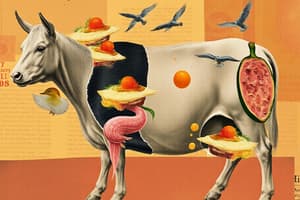Podcast
Questions and Answers
Which of the following best describes the function of microbiome bacteria in digestion?
Which of the following best describes the function of microbiome bacteria in digestion?
- They help in the fermentation of proteins.
- They aid in breaking down complex carbohydrates. (correct)
- They primarily function in the absorption of fats.
- They produce hormones for digestion.
Ruminants have a single-chambered stomach for digestion.
Ruminants have a single-chambered stomach for digestion.
False (B)
What organ in humans begins the digestion of carbohydrates?
What organ in humans begins the digestion of carbohydrates?
mouth
Birds utilize a specialized ______ for food storage before grinding in the gizzard.
Birds utilize a specialized ______ for food storage before grinding in the gizzard.
Match each organism with its unique digestive feature:
Match each organism with its unique digestive feature:
Which of the following animals is an example of a ruminant?
Which of the following animals is an example of a ruminant?
All carnivores have prominent incisors that are used for chewing plants.
All carnivores have prominent incisors that are used for chewing plants.
What is the primary function of the molars in herbivores?
What is the primary function of the molars in herbivores?
Filter feeders, like __________ and __________, strain tiny food particles from water using modified gills.
Filter feeders, like __________ and __________, strain tiny food particles from water using modified gills.
Match the following animal groups with their characteristics:
Match the following animal groups with their characteristics:
What adaptation do herbivores have in their jaws to assist with grinding food?
What adaptation do herbivores have in their jaws to assist with grinding food?
Omnivores only eat plants and do not consume animal products.
Omnivores only eat plants and do not consume animal products.
What type of teeth do carnivores typically have to assist in their diet?
What type of teeth do carnivores typically have to assist in their diet?
Flashcards
Filter feeder
Filter feeder
An animal that strains tiny food particles from water.
Carnivore mouthparts
Carnivore mouthparts
Sharp, pointed teeth for tearing and piercing prey.
Herbivore incisors
Herbivore incisors
Large, chisel-shaped teeth for clipping and cutting plant material.
Herbivore molars
Herbivore molars
Signup and view all the flashcards
Carnivore jaws
Carnivore jaws
Signup and view all the flashcards
Herbivore jaws
Herbivore jaws
Signup and view all the flashcards
Carnivore skull shape
Carnivore skull shape
Signup and view all the flashcards
Herbivore skull shape
Herbivore skull shape
Signup and view all the flashcards
Optimized Protein Digestion
Optimized Protein Digestion
Signup and view all the flashcards
Cellulose Digestion
Cellulose Digestion
Signup and view all the flashcards
Microbiome Benefit
Microbiome Benefit
Signup and view all the flashcards
Human Digestive System
Human Digestive System
Signup and view all the flashcards
Ruminant Digestion
Ruminant Digestion
Signup and view all the flashcards
Study Notes
Animal Feeding Strategies
-
Filter feeders strain tiny food particles from water using structures like modified gills or nets.
- Examples: Sponges, blue whales
-
Cnidarians are aquatic invertebrates with tentacles and stinging cells used for capturing prey.
- Examples: Jellyfish, sea anemones
-
Ruminants are herbivores with specialized stomachs for digesting cellulose. This involves re-chewing (regurgitation and rumination).
- Examples: Cows, giraffes
-
Herbivores eat plants or algae.
- Examples: Kangaroos, rabbits
-
Carnivores eat other animals, using sharp teeth or venom to catch and consume prey.
- Examples: Wolves, spiders
-
Omnivores eat both plants and animals.
- Examples: Bears, humans
-
Detritivores feed on decomposing organic material.
- Examples: Earthworms, millipedes
Carnivore vs. Herbivore Mouthparts
- Incisors (Carnivores): Small and less prominent, used for nibbling or scraping meat.
- Incisors (Herbivores): Large, chisel-shaped, used to clip or cut plant material.
- Canines (Carnivores): Long, sharp, pointed, used for piercing, gripping, and tearing.
- Canines (Herbivores): Small or absent.
- Molars/Premolars (Carnivores): Sharp and jagged, act like scissors to slice through muscle and bone.
- Molars/Premolars (Herbivores): Broad and flat, used for crushing and grinding tough plant fibers.
- Jaws (Carnivores): Short, strong, primarily move up and down for a powerful shearing bite.
- Jaws (Herbivores): Longer jaws, allowing side-to-side grinding motion.
- Skull Shape (Carnivores): Narrow to maximize biting force.
- Skull Shape (Herbivores): Elongated to accommodate chewing muscles.
- Tongue (Carnivores): Rough or textured to scrape and clean meat.
- Tongue (Herbivores): Smooth to manipulate and push plant material.
- Other Adaptations (Herbivores): Diastema (gap between incisors and molars), allows moving food back for grinding. Sharp claws, optimized to process high-protein diets quickly.
Microbiome Bacteria
- Microbiome bacteria break down complex carbohydrates (like cellulose).
- They produce essential vitamins like Vitamin K and certain B vitamins.
- Enhance immunity by competing with harmful bacteria.
- Aid in nutrient absorption.
Food Processing in Different Animals
-
Humans: Use a one-way system (mouth, stomach, intestines, enzymes)
-
Ruminants: Multi-chambered stomachs (rumen) for fermenting plant material with microbes.
-
Birds: Specialized crop (storage) and gizzard (grinding).
-
Sponges: Filter feeding, drawing water through pores, trapping particles.
-
Cnidarians: Gastrovascular cavity for digestion and absorption.
-
Specific features:
- Humans: Enzymes in saliva start breaking down carbohydrates.
- Cnidarians: Gastrovascular cavity.
- Sponges: Choanocytes (collar cells) filter food.
- Birds: Gizzard uses grit to grind food.
- Ruminants: Rumen contains microbes to digest cellulose.
Studying That Suits You
Use AI to generate personalized quizzes and flashcards to suit your learning preferences.




